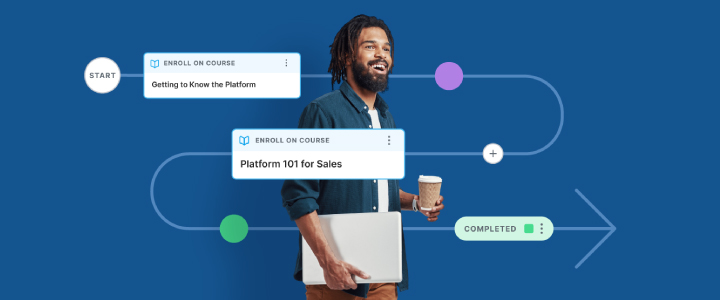
4 min reading time
How to Use Constructivist Learning Theory in a Corporate Environment
Constructivist Learning Theory is centered around the idea that learners are active participants in their own learning and training. This shapes and gives meaning to the knowledge they acquire by relating it to their prior knowledge and experiences. Constructivism says the best way to learn is to try a concept out for yourself and then reflect on that experience. The theory was pioneered by educational philosophers and reformers including Jean Piaget, John Dewey and Maria Montessori, among others in the late 19th century.
It was described as follows by educational researcher Jacqueline Brooks in 1999: “As long as there were people asking each other questions, we have had constructivist classrooms. Constructivism, the study of learning, is about how we all make sense of our world, and that really hasn’t changed.”
Constructivist Learning Theory suggests that while knowledge can be given to learners, understanding cannot be – it has to come from within. Learners construct their own interpretations of the information they’re given in a training session. They contextualize it alongside their own experiences, and test the new information against what they already know about the world. They may then change their views in light of the new information, or discard it as irrelevant.
It’s likely that some degree of constructivism is already happening in your workplace. In fact, every time a group identifies a problem and works together to solve it, they’re informally engaging in a constructivist process, a topic we’ve written lots about before.
Benefits of a Constructivist approach to learning
There are numerous benefits to implementing training based on constructivist learning theory;
- learners often enjoy the process more when they’re encouraged to relate it to their own experience so they learn and remember more;
- they see the relevance of the training because they put the new knowledge into practice straight away;
- learners focus on thinking and understanding – more important skills than memorization;
- this paradigm helps to develop learners’ social skills, ability to communicate their thoughts and encourages autonomy.
The characteristics of constructivist learning
In traditional corporate training environments, instructors are active agents. They impart your organization’s knowledge to a room of employees, partners, or customers who sat passively and tried to absorb the information. Your instructors were in a position of authority, and your expertise were unquestionable.
Using Constructivist Learning Theory, your instructors see themselves as facilitators or guides. Instead of simply being told the answers, learners often work in groups to tackle problems and come up with solutions together. You share authority with your learners, encouraging them to think for themselves.
In a traditional setting, the instructor usually stays at the top of the classroom, lecturing the learners; while in a constructivist learning environment, instructors are more likely to walk around between the groups, engaging them and asking thought-provoking questions to lead them toward the right solutions.
The Constructivist approach to learning: Putting it into practice
Constructivist training is learner-oriented. It aims to let participants put new information into action as soon as possible. Here are some examples of how to use it in your next session:
1. Role-play activities
Role-play is a form of Constructivist Learning Theory that can be applied in many corporate training sessions. For example, with Customer Service, Sales and Support training, constructivist instructors in a face-to-face session can divide a group of trainees into small groups. Or using a Learning Management System, it can be done by running live training sessions or interactive video.
Instead of reading through protocols or listening to you describing the correct way to answer an inquiry, learners actively take part by playing the role of both the customer and the employee. This allows learners to relate the training to similar experiences they have had in the past, and to find the best way of solving the customer’s problem or making a sale.
2. Collaborative problem-solving
Training regularly asks employees to participate with idea-generation or problem-solving exercises. These are aimed at resolving the real-world challenges that the business is facing. These types of training sessions are ideal occasions to implement constructivism.
Asking people to contribute on an individual basis can be seen as intimidating. Instead, during face-to-face sessions divide participants into groups. They can work together to come up with solutions gets teams engaging with each other, bouncing ideas off each other and improve or expand upon the best ones.
Alternatively, using your LMS you can set up a forum for discussion. A question can be put forward, and your teams can work together and comment back and forth on the best solution to overcome potential issues.
3. Hold a debate
Often, training is held when a business has gone through a transformation. Perhaps there is an aspect of that change that is new, different, or even controversial. Change management can be an important function of corporate learning sessions.
Instead of simply extolling the benefits of the new system via a Word Doc or presentation, , you can get learners engaged by staging a debate. Again, this can be done face-to-face or online via your LMS. You can divide the employees three groups; those in favor of the change, those against it, and the remainder as adjudicators deciding who wins. And either in person or in your LMS forum they can jostle it out.
In this way, each participant has a stake in the debate. The new changes will be explored in detail, and new opportunities and benefits will be identified as well as the potential challenges. Learners will also feel they have had the opportunity to express themselves, and – ideally – will conclude that the new changes are ultimately for the common good.
4. Challenges of implementing Constructivist Learning
From an organization’s point of view, planning a training session is be time-consuming as you need to come up with practical ways to engage learners. This type of training might also require more props, new course content, and getting through the material could take some extra time.
Since learners get the opportunity to put their views across and relate to the material in their own way, it can sometimes be hard to predict the direction a training session is going to take, so you need to be able to “go with the flow”.
Do you use Constructivist Learning Theory in your training sessions? What are your favorite methods of getting your trainees actively involved in the learning process? Leave a comment below and let us know.



